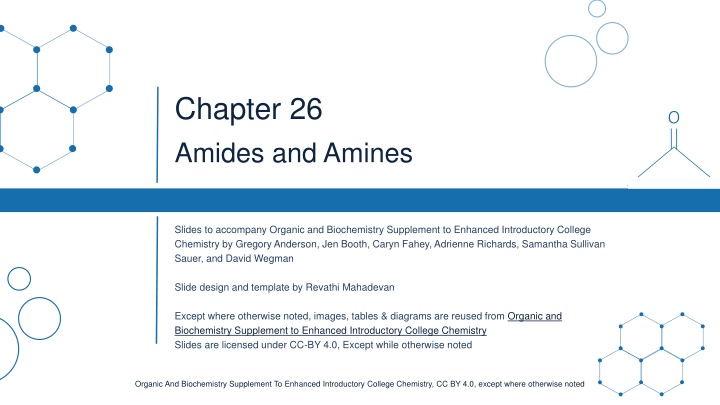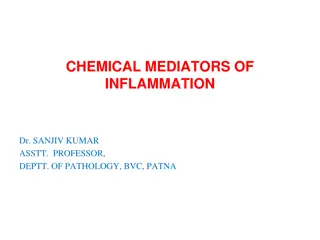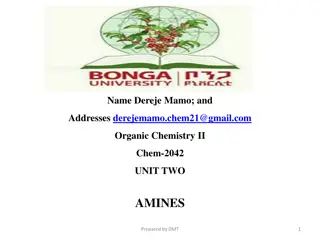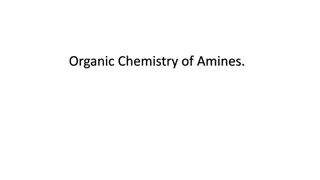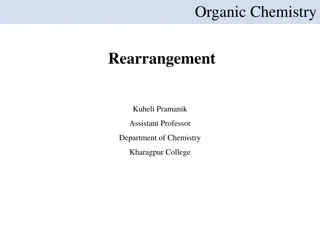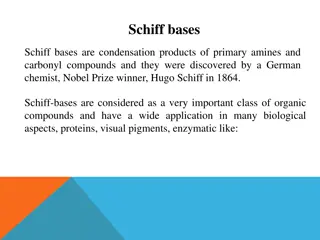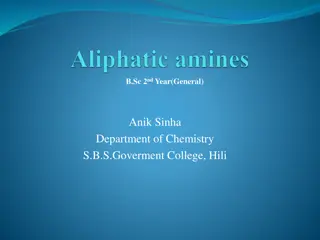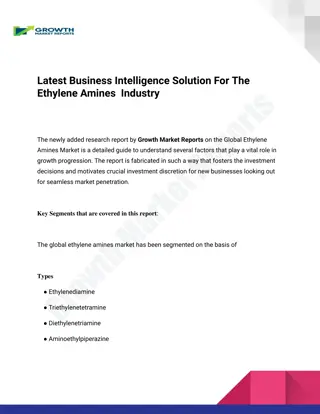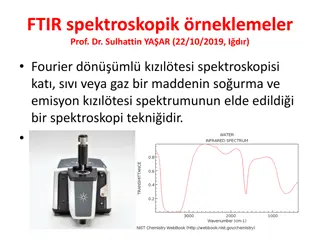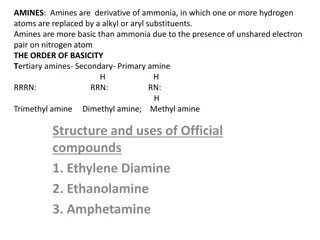Chapter 26: Amides and Amines
Explore the characteristics and reactions of amides and amines through a detailed presentation accompanying "Organic and Biochemistry Supplement to Enhanced Introductory College Chemistry." Learn about the distinct odour of fish, nucleophilic acyl substitution reactions, functional groups of amides, and examples of various amines. Enhance your understanding of organic compounds with these informative slides.
Download Presentation

Please find below an Image/Link to download the presentation.
The content on the website is provided AS IS for your information and personal use only. It may not be sold, licensed, or shared on other websites without obtaining consent from the author.If you encounter any issues during the download, it is possible that the publisher has removed the file from their server.
You are allowed to download the files provided on this website for personal or commercial use, subject to the condition that they are used lawfully. All files are the property of their respective owners.
The content on the website is provided AS IS for your information and personal use only. It may not be sold, licensed, or shared on other websites without obtaining consent from the author.
E N D
Presentation Transcript
Chapter 26 Amides and Amines O Slides to accompany Organic and Biochemistry Supplement to Enhanced Introductory College Chemistry by Gregory Anderson, Jen Booth, Caryn Fahey, Adrienne Richards, Samantha Sullivan Sauer, and David Wegman Slide design and template by Revathi Mahadevan Except where otherwise noted, images, tables & diagrams are reused from Organic and Biochemistry Supplement to Enhanced Introductory College Chemistry Slides are licensed under CC-BY 4.0, Except while otherwise noted Organic And Biochemistry Supplement To Enhanced Introductory College Chemistry, CC BY 4.0, except where otherwise noted Organic And Biochemistry Supplement To Enhanced Introductory College Chemistry, CC BY 4.0, except where otherwise noted
Figure 26.0a Figure 26.0a. The characteristic and unmistakable odour of fish is due to a mixture of simple alkylamines. (credit: Photo by Dudva, CC BY-SA 4.0) Organic And Biochemistry Supplement To Enhanced Introductory College Chemistry, CC BY 4.0, except where otherwise noted Organic And Biochemistry Supplement To Enhanced Introductory College Chemistry, CC BY 4.0, except where otherwise noted
Figure 26.0b Figure 26.0b. A nucleophilic acyl substitution reaction of carboxylic acid derivative. (credit: Organic Chemistry (OpenStax), CC BY-NC-SA 4.0) Organic And Biochemistry Supplement To Enhanced Introductory College Chemistry, CC BY 4.0, except where otherwise noted Organic And Biochemistry Supplement To Enhanced Introductory College Chemistry, CC BY 4.0, except where otherwise noted
Figure 26.0c Figure 26.0c. The image represents the functional groups for amides. It also shows two specific examples of amides. (credit: Chemistry 2e (OpenStax), CC BY 4.0) Organic And Biochemistry Supplement To Enhanced Introductory College Chemistry, CC BY 4.0, except where otherwise noted Organic And Biochemistry Supplement To Enhanced Introductory College Chemistry, CC BY 4.0, except where otherwise noted
Figure 26.0d Figure 26.0d. Summary of Organic Compounds (credit: Chemistry 2e (OpenStax), CC BY 4.0) Organic And Biochemistry Supplement To Enhanced Introductory College Chemistry, CC BY 4.0, except where otherwise noted Organic And Biochemistry Supplement To Enhanced Introductory College Chemistry, CC BY 4.0, except where otherwise noted
Figure 26.1a Figure 26.1a. Examples of amines. (Credit: Chemistry 2e, OpenStax, CC BY 4.0) Organic And Biochemistry Supplement To Enhanced Introductory College Chemistry, CC BY 4.0, except where otherwise noted Organic And Biochemistry Supplement To Enhanced Introductory College Chemistry, CC BY 4.0, except where otherwise noted
Figure 26.1b Figure 26.1b. The illustration shows one of the resonance structures of pyridine. (Credit: Chemistry 2e, OpenStax, CC BY 4.0) Organic And Biochemistry Supplement To Enhanced Introductory College Chemistry, CC BY 4.0, except where otherwise noted Organic And Biochemistry Supplement To Enhanced Introductory College Chemistry, CC BY 4.0, except where otherwise noted
Figure 26.1c Figure 26.1c. The Structure of Amines Compared to Water, an Alcohol, and an Ether. (Credit: Intro Chem: GOB (V. 1.0)., CC BY-NC-SA 3.0.) Organic And Biochemistry Supplement To Enhanced Introductory College Chemistry, CC BY 4.0, except where otherwise noted Organic And Biochemistry Supplement To Enhanced Introductory College Chemistry, CC BY 4.0, except where otherwise noted
Figure 26.1d Figure 26.1d. Comparison of tertiary alcohol and tertiary amine. (Credit: Organic Chemistry, OpenStax, CC BY-NC-SA 4.0) Organic And Biochemistry Supplement To Enhanced Introductory College Chemistry, CC BY 4.0, except where otherwise noted Organic And Biochemistry Supplement To Enhanced Introductory College Chemistry, CC BY 4.0, except where otherwise noted
Figure 26.1e Figure 26.1e. Comparison of an amine and an alcohol. (Credit: Intro Chem: GOB (V. 1.0)., CC BY-NC-SA 3.0.) Organic And Biochemistry Supplement To Enhanced Introductory College Chemistry, CC BY 4.0, except where otherwise noted Organic And Biochemistry Supplement To Enhanced Introductory College Chemistry, CC BY 4.0, except where otherwise noted
Figure 26.1f Figure 26.1f. Example of a quaternary salt. (Credit: Organic Chemistry, OpenStax, CC BY-NC-SA 4.0) Organic And Biochemistry Supplement To Enhanced Introductory College Chemistry, CC BY 4.0, except where otherwise noted Organic And Biochemistry Supplement To Enhanced Introductory College Chemistry, CC BY 4.0, except where otherwise noted
Figure 26.1g Figure 26.1g. Linear and ring structure examples of amines. (Credit: Organic Chemistry, OpenStax, CC BY-NC-SA 4.0) Organic And Biochemistry Supplement To Enhanced Introductory College Chemistry, CC BY 4.0, except where otherwise noted Organic And Biochemistry Supplement To Enhanced Introductory College Chemistry, CC BY 4.0, except where otherwise noted
Figure 26.1h Figure 26.1h. Examples of naming amines. (Credit: Organic Chemistry, OpenStax, CC BY-NC-SA 4.0) Organic And Biochemistry Supplement To Enhanced Introductory College Chemistry, CC BY 4.0, except where otherwise noted Organic And Biochemistry Supplement To Enhanced Introductory College Chemistry, CC BY 4.0, except where otherwise noted
Figure 26.1i Figure 26.1i. Examples of naming amines with more than one functional group. (Credit: Organic Chemistry, OpenStax, CC BY-NC-SA 4.0) Organic And Biochemistry Supplement To Enhanced Introductory College Chemistry, CC BY 4.0, except where otherwise noted Organic And Biochemistry Supplement To Enhanced Introductory College Chemistry, CC BY 4.0, except where otherwise noted
Figure 26.1j Figure 26.1j. Examples of symmetrical secondary and tertiary amines. (Credit: Organic Chemistry, OpenStax, CC BY-NC-SA 4.0) Organic And Biochemistry Supplement To Enhanced Introductory College Chemistry, CC BY 4.0, except where otherwise noted Organic And Biochemistry Supplement To Enhanced Introductory College Chemistry, CC BY 4.0, except where otherwise noted
Figure 26.1k Figure 26.1k. Examples of unsymmetrical secondary and tertiary amines. (Credit: Organic Chemistry, OpenStax, CC BY-NC-SA 4.0) Organic And Biochemistry Supplement To Enhanced Introductory College Chemistry, CC BY 4.0, except where otherwise noted Organic And Biochemistry Supplement To Enhanced Introductory College Chemistry, CC BY 4.0, except where otherwise noted
Figure 26.2a Figure 26.2a. Hydrogen Bonding. (a) Amine molecules are associated through hydrogen bonding. (b) An amine molecule can form a hydrogen bond with water molecules (credit: Intro Chem: GOB (V. 1.0)., CC BY-NC-SA 3.0). Organic And Biochemistry Supplement To Enhanced Introductory College Chemistry, CC BY 4.0, except where otherwise noted Organic And Biochemistry Supplement To Enhanced Introductory College Chemistry, CC BY 4.0, except where otherwise noted
Table 26.2a. Table 26.2a. Physical Properties of Some Amines and Comparable Oxygen-Containing Compounds Condensed Structural Formula Solubility at 25 C (g/100 g Water) Name Class Molar Mass Boiling Point ( C) butylamine CH3CH2CH2CH2NH2 (CH3CH2)2NH CH3CH2CH2CH2OH (CH3CH2CH2)2NH (CH3CH2)3N (CH3CH2CH2)2O 1 73 78 miscible diethylamine 2 73 55 miscible butyl alcohol 74 118 8 dipropylamine 2 101 111 4 triethylamine 3 101 90 14 dipropyl ether 102 91 0.25 Source: "15.11: Physical Properties of Amines" In Basics of GOB Chemistry (Ball et al.), CC BY-NC-SA 4.0. Organic And Biochemistry Supplement To Enhanced Introductory College Chemistry, CC BY 4.0, except where otherwise noted Organic And Biochemistry Supplement To Enhanced Introductory College Chemistry, CC BY 4.0, except where otherwise noted
Figure 26.2b Figure 26.2b. Structure of beta-naphthylamine. (Credit: Intro Chem: GOB (V. 1.0)., CC BY-NC-SA 3.0) Organic And Biochemistry Supplement To Enhanced Introductory College Chemistry, CC BY 4.0, except where otherwise noted Organic And Biochemistry Supplement To Enhanced Introductory College Chemistry, CC BY 4.0, except where otherwise noted
Figure 26.3a Figure 26.3a. Examples of heterocyclic amines. (Credit: Organic Chemistry, OpenStax, CC BY-NC-SA 4.0) Organic And Biochemistry Supplement To Enhanced Introductory College Chemistry, CC BY 4.0, except where otherwise noted Organic And Biochemistry Supplement To Enhanced Introductory College Chemistry, CC BY 4.0, except where otherwise noted
Figure 26.3b Figure 26.3b. Structural diagram for Caffeine (credit: Intro Chem: GOB (V. 1.0)., CC BY-NC-SA 3.0). Organic And Biochemistry Supplement To Enhanced Introductory College Chemistry, CC BY 4.0, except where otherwise noted Organic And Biochemistry Supplement To Enhanced Introductory College Chemistry, CC BY 4.0, except where otherwise noted
Figure 26.3c Figure 26.3c. Structural diagram for Nicotine (credit: Intro Chem: GOB (V. 1.0)., CC BY-NC-SA 3.0). Organic And Biochemistry Supplement To Enhanced Introductory College Chemistry, CC BY 4.0, except where otherwise noted Organic And Biochemistry Supplement To Enhanced Introductory College Chemistry, CC BY 4.0, except where otherwise noted
Figure 26.3d Figure 26.3d. Structural diagram for Cocaine (credit: Intro Chem: GOB (V. 1.0)., CC BY-NC-SA 3.0). Organic And Biochemistry Supplement To Enhanced Introductory College Chemistry, CC BY 4.0, except where otherwise noted Organic And Biochemistry Supplement To Enhanced Introductory College Chemistry, CC BY 4.0, except where otherwise noted
Figure 26.3e Figure 26.3e. Chemical reaction of Cocaine with Hydrochloric acid. (credit: Intro Chem: GOB (V. 1.0)., CC BY-NC-SA 3.0). Organic And Biochemistry Supplement To Enhanced Introductory College Chemistry, CC BY 4.0, except where otherwise noted Organic And Biochemistry Supplement To Enhanced Introductory College Chemistry, CC BY 4.0, except where otherwise noted
Figure 26.4a Figure 26.4a. Amines accepting protons from water to form ions (credit: Intro Chem: GOB (V. 1.0)., CC BY-NC-SA 3.0). Organic And Biochemistry Supplement To Enhanced Introductory College Chemistry, CC BY 4.0, except where otherwise noted Organic And Biochemistry Supplement To Enhanced Introductory College Chemistry, CC BY 4.0, except where otherwise noted
Figure 26.4b Figure 26.4b. Specific reaction of methylamine with water (credit: Intro Chem: GOB (V. 1.0)., CC BY-NC- SA 3.0). Organic And Biochemistry Supplement To Enhanced Introductory College Chemistry, CC BY 4.0, except where otherwise noted Organic And Biochemistry Supplement To Enhanced Introductory College Chemistry, CC BY 4.0, except where otherwise noted
Figure 26.4c Figure 26.4c. An insoluble amine reacting with an acid to form a soluble salt (credit: Intro Chem: GOB (V. 1.0)., CC BY-NC-SA 3.0). Organic And Biochemistry Supplement To Enhanced Introductory College Chemistry, CC BY 4.0, except where otherwise noted Organic And Biochemistry Supplement To Enhanced Introductory College Chemistry, CC BY 4.0, except where otherwise noted
Figure 26.5a Figure 26.5a. Amide groups (Credit: Introduction to Chemistry: GOB (V. 1.0)., CC BY-NC-SA 3.0). Organic And Biochemistry Supplement To Enhanced Introductory College Chemistry, CC BY 4.0, except where otherwise noted Organic And Biochemistry Supplement To Enhanced Introductory College Chemistry, CC BY 4.0, except where otherwise noted
Figure 26.5b Figure 26.5b. Comparison of Formic acid and Formamide (Credit: Introduction to Chemistry: GOB (V. 1.0)., CC BY-NC-SA 3.0). Organic And Biochemistry Supplement To Enhanced Introductory College Chemistry, CC BY 4.0, except where otherwise noted Organic And Biochemistry Supplement To Enhanced Introductory College Chemistry, CC BY 4.0, except where otherwise noted
Figure 26.5c Figure 26.5c. Basic structure of an amide showcasing functional groups (credit: General Chemistry 1 & 2 , CC BY 4.0). Organic And Biochemistry Supplement To Enhanced Introductory College Chemistry, CC BY 4.0, except where otherwise noted Organic And Biochemistry Supplement To Enhanced Introductory College Chemistry, CC BY 4.0, except where otherwise noted
Figure 26.5d Figure 26.5d. Chemical reaction for formation of an amide (credit: General Chemistry 1 & 2 , CC BY 4.0). Organic And Biochemistry Supplement To Enhanced Introductory College Chemistry, CC BY 4.0, except where otherwise noted Organic And Biochemistry Supplement To Enhanced Introductory College Chemistry, CC BY 4.0, except where otherwise noted
Figure 26.5e Figure 26.5e. The molecular structure of urea (credit: Image by NEUROtiker, PDM). Organic And Biochemistry Supplement To Enhanced Introductory College Chemistry, CC BY 4.0, except where otherwise noted Organic And Biochemistry Supplement To Enhanced Introductory College Chemistry, CC BY 4.0, except where otherwise noted
Table 26.5a. Table 26.5a. Physical Constants of Some Unsubstituted Amides Condensed Structural Formula Melting Point ( C) Boiling Point ( C) Solubility in Water Name HCONH2 formamide 2 193 soluble CH3CONH2 acetamide 82 222 soluble CH3CH2CONH2 propionamide 81 213 soluble CH3CH2CH2CONH2 butyramide 115 216 soluble C6H5CONH2 benzamide 132 290 Slightly soluble Source: "15.14: Physical Properties of Amides" In Basics of GOB Chemistry (Ball et al.), CC BY-NC-SA 4.0. Organic And Biochemistry Supplement To Enhanced Introductory College Chemistry, CC BY 4.0, except where otherwise noted Organic And Biochemistry Supplement To Enhanced Introductory College Chemistry, CC BY 4.0, except where otherwise noted
Figure 26.5f Figure 26.5f. Hydrogen Bonding in Amides. Amide molecules can engage in hydrogen bonding with water molecules (a). Those amides with a hydrogen atom on the nitrogen atom can also engage in hydrogen bonding (b). Both hydrogen bonding networks extend in all directions. (Credit: Intro Chem: GOB (V. 1.0)., CC BY-NC-SA 3.0, edited by (Ball et al.), CC BY-NC-SA 4.0) Organic And Biochemistry Supplement To Enhanced Introductory College Chemistry, CC BY 4.0, except where otherwise noted Organic And Biochemistry Supplement To Enhanced Introductory College Chemistry, CC BY 4.0, except where otherwise noted
Figure 26.5g Figure 26.5g. The molecular structure of urea. (credit: Image by NEUROtiker, PDM). Organic And Biochemistry Supplement To Enhanced Introductory College Chemistry, CC BY 4.0, except where otherwise noted Organic And Biochemistry Supplement To Enhanced Introductory College Chemistry, CC BY 4.0, except where otherwise noted
Figure 26.6a Figure 26.6a. Hydrolysis of an amide in acid solution actually gives a carboxylic acid and the salt of ammonia or an amine (the ammonia or amine initially formed is neutralized by the acid). Basic hydrolysis gives a salt of the carboxylic acid and ammonia or an amine. (Credit: Intro Chem: GOB (V. 1.0)., CC BY- NC-SA 3.0) Organic And Biochemistry Supplement To Enhanced Introductory College Chemistry, CC BY 4.0, except where otherwise noted Organic And Biochemistry Supplement To Enhanced Introductory College Chemistry, CC BY 4.0, except where otherwise noted
Figure 26.6b Figure 26.6b. Solution for reaction of butyramide and water. (credit: Intro Chem: GOB (V. 1.0)., CC BY- NC-SA 3.0) Organic And Biochemistry Supplement To Enhanced Introductory College Chemistry, CC BY 4.0, except where otherwise noted Organic And Biochemistry Supplement To Enhanced Introductory College Chemistry, CC BY 4.0, except where otherwise noted
Figure 26.6c Figure 26.6c. Reaction of benzamide and water. (credit: Intro Chem: GOB (V. 1.0)., CC BY-NC-SA 3.0) Organic And Biochemistry Supplement To Enhanced Introductory College Chemistry, CC BY 4.0, except where otherwise noted Organic And Biochemistry Supplement To Enhanced Introductory College Chemistry, CC BY 4.0, except where otherwise noted
Figure 26.6d Figure 26.6d. Reaction of acetic acid with ammonia. (Credit: Intro Chem: GOB (V. 1.0)., CC BY-NC-SA 3.0) Organic And Biochemistry Supplement To Enhanced Introductory College Chemistry, CC BY 4.0, except where otherwise noted Organic And Biochemistry Supplement To Enhanced Introductory College Chemistry, CC BY 4.0, except where otherwise noted
Figure 26.6e Figure 26.6e. Reaction of a carboxylic aid and amine produce an amide and water. (Credit: Chemistry (OpenStax), CC BY 4.0) Organic And Biochemistry Supplement To Enhanced Introductory College Chemistry, CC BY 4.0, except where otherwise noted Organic And Biochemistry Supplement To Enhanced Introductory College Chemistry, CC BY 4.0, except where otherwise noted
Figure 26.6f Figure 26.6f. Formation of an ester. (Credit: Intro Chem: GOB (V. 1.0)., CC BY-NC-SA 3.0) Organic And Biochemistry Supplement To Enhanced Introductory College Chemistry, CC BY 4.0, except where otherwise noted Organic And Biochemistry Supplement To Enhanced Introductory College Chemistry, CC BY 4.0, except where otherwise noted
Figure 26.6g Figure 26.6g. Formation of an amide. (Credit: Intro Chem: GOB (V. 1.0)., CC BY-NC-SA 3.0) Organic And Biochemistry Supplement To Enhanced Introductory College Chemistry, CC BY 4.0, except where otherwise noted Organic And Biochemistry Supplement To Enhanced Introductory College Chemistry, CC BY 4.0, except where otherwise noted
Figure 26.6h Figure 26.6h. Reaction of an amide with lithium aluminum hydride and hydrolysis to form an amine (Credit: Organic Chemistry (OpenStax), CC BY-NC-SA 4.0). Organic And Biochemistry Supplement To Enhanced Introductory College Chemistry, CC BY 4.0, except where otherwise noted Organic And Biochemistry Supplement To Enhanced Introductory College Chemistry, CC BY 4.0, except where otherwise noted
Figure 26.6i Figure 26.6i. Reduction of an amide with lithium aluminum hydride to produce N-ethylaniline (Credit: Organic Chemistry (OpenStax), CC BY-NC-SA 4.0). Organic And Biochemistry Supplement To Enhanced Introductory College Chemistry, CC BY 4.0, except where otherwise noted Organic And Biochemistry Supplement To Enhanced Introductory College Chemistry, CC BY 4.0, except where otherwise noted
Figure 26.6j Figure 26.6j. Reduction of an amide with lithium aluminum hydride and hydrolysis to form an N- Ethylaniline. (Credit: Organic Chemistry (OpenStax), CC BY-NC-SA 4.0). Organic And Biochemistry Supplement To Enhanced Introductory College Chemistry, CC BY 4.0, except where otherwise noted Organic And Biochemistry Supplement To Enhanced Introductory College Chemistry, CC BY 4.0, except where otherwise noted
Figure 26.6k Figure 26.6k. Reduction of a nitrile to form a primary amine. (credit: Organic Chemistry (Morsch et al.), CC BY-SA 4.0. ) Organic And Biochemistry Supplement To Enhanced Introductory College Chemistry, CC BY 4.0, except where otherwise noted Organic And Biochemistry Supplement To Enhanced Introductory College Chemistry, CC BY 4.0, except where otherwise noted
Figure 26.6l Figure 26.6l. Prediction of product of nitrile reduction (credit: Organic Chemistry (Morsch et al.), CC BY- SA 4.0). Organic And Biochemistry Supplement To Enhanced Introductory College Chemistry, CC BY 4.0, except where otherwise noted Organic And Biochemistry Supplement To Enhanced Introductory College Chemistry, CC BY 4.0, except where otherwise noted
Figure 26.6m Figure 26.6m. Formation of primary amine from ammonia, secondary amine from primary amine, and tertiary amine from secondary amine through alkylation (credit: Supplemental Modules, CC BY-NC 4.0 / Adapted by Samantha Sullivan Sauer / Biovia Draw) Organic And Biochemistry Supplement To Enhanced Introductory College Chemistry, CC BY 4.0, except where otherwise noted Organic And Biochemistry Supplement To Enhanced Introductory College Chemistry, CC BY 4.0, except where otherwise noted
